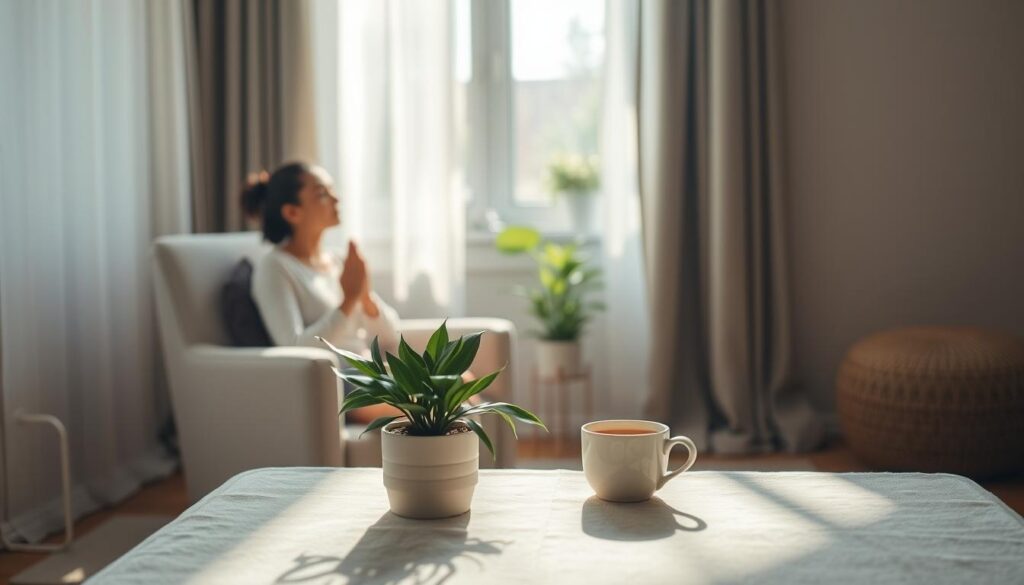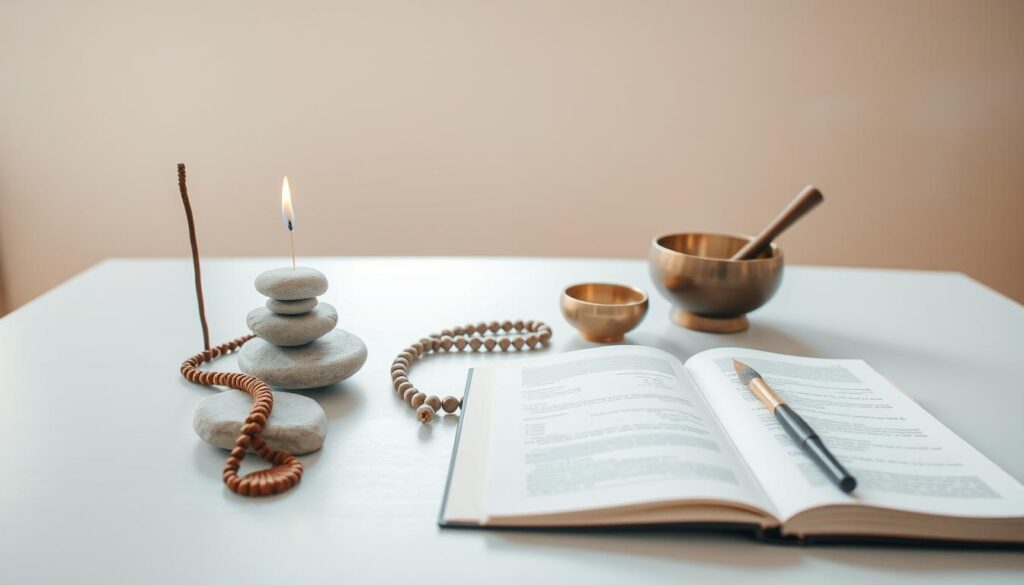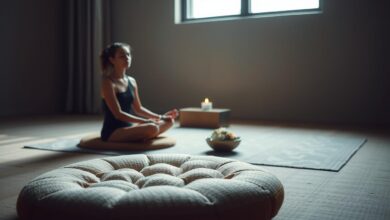Discover Mindfulness: Essential Exercises for Beginners

Imagine being overwhelmed by endless tasks and distractions. That feeling of tightness in your chest and a racing mind is exhausting. Mindfulness is more than just a trend; it’s a way to find peace in chaos.
This article will guide you to calm in the midst of chaos with simple steps. Whether you’re dealing with work, family, or daily noise, these mindfulness exercises for beginners are for you.
Life is fast, but you can slow down without stopping. Mindfulness is that magic. These easy mindfulness exercises require no special time or equipment—just curiosity. You’ll learn to breathe better, notice small moments, and handle stress better. No experience needed; this journey begins where you are.
Key Takeaways
- Even 5 minutes of easy mindfulness exercises can reduce stress and improve focus.
- Mindfulness adapts to your schedule—no need to overhaul your life.
- Simple practices like breath awareness or mindful eating build resilience over time.
- Anyone can start today with these mindfulness exercises for beginners.
- Small steps create lasting change—this guide shows you how.
What is Mindfulness?
Mindfulness is about focusing on the present moment. For beginner mindfulness practices, it means watching your thoughts and feelings without judgment. This skill can change how you see everyday life, whether you’re new to mindfulness for newcomers.
Understanding the Concept
Jon Kabat-Zinn says mindfulness is about paying attention on purpose, in the present, and without judgment. This practice, based on Buddhist teachings, helps millions deal with stress and find clarity. It’s not about clearing your mind but noticing what’s happening now, like the warmth of sunlight or the sound of your breath.
“Mindfulness isn’t difficult; we just need to remember to do it.”
Benefits of Practicing Mindfulness
- Reduces anxiety by grounding you in the here and now
- Sharpens focus through intentional observation of thoughts
- Builds emotional resilience by accepting feelings without reacting impulsively
- Enhances relationships by fostering active listening and empathy
Mindfulness in Everyday Life
Beginner mindfulness practices don’t need special tools. Try pausing for 30 seconds to notice the taste of coffee, the texture of your socks, or the colors around you. Even simple tasks like walking or washing dishes can become mindful moments. The goal is to fully engage with what you’re doing, turning daily routines into chances for calm.
Getting Started with Mindfulness
Before starting mindfulness activities, getting ready is key. These beginner mindfulness tips will help you begin on the right path.
Setting Intentions
Start by thinking about why you want to practice. Write down your goals in a journal. Maybe you want to reduce stress or improve focus. Being clear about your goals helps you stay committed.
- Use prompts like, “I want to feel more present during meals.”
- Keep your list visible to revisit weekly.
Creating a Mindful Environment
“A cluttered space often leads to a cluttered mind—design your space to reflect your goals.”
Choose a quiet spot in your home. Add things like a cushion, plants, or soft lighting. These small steps make your space welcoming. Try:
- Declutter the area before sessions.
- Add calming scents with essential oils or candles.
Choosing the Right Time and Place
Link mindfulness with your daily routines. For example:
| Time of Day | Best For | Tips |
|---|---|---|
| Mornings | Setting a calm tone | Practice before checking emails. |
| Night | Unwinding | Use dim lighting to ease into relaxation. |
Begin with 1-3 minutes each day. As you get more comfortable, you can do more. Remember, it’s the regular practice that counts, not how long you do it!
Simple Mindfulness Exercises
Try these simple mindfulness activities to stay present. You don’t need any special tools. Just a few moments of focus are enough.
Breath Awareness
Sit comfortably. Place one hand on your chest, the other on your belly. Inhale deeply through your nose, feeling your stomach rise. Exhale slowly through your mouth, letting go of tension.
If thoughts drift, gently return focus to your breath. Easy mindfulness exercises like this help you handle stress better.
- Inhale for four counts.
- Hold for two seconds.
- Exhale for six counts.
Wandering minds are normal. Try counting breaths to stay focused.
Body Scan Technique
Lie down, closing your eyes. Start at your toes, noticing sensations. Move upward, scanning each body part.
Tightness in shoulders? Imagine warmth melting stiffness. This practice boosts body awareness and relaxation.
- Take 5-10 minutes daily.
- Use a guided audio if needed.
Skip areas of pain; focus where you feel most tension first.
Five Senses Exercise
When stressed, pause. Name five things you see, four you can touch, three you hear, two smells, and one taste. This easy mindfulness exercise shifts focus from worry to the here and now.
“Sensory grounding lowers anxiety by redirecting attention to tangible details.”
Practice these routines for 2-5 minutes daily. Consistency turns them into lifelong tools for calm.
Mindfulness Meditation Techniques
Explore structured mindfulness meditation techniques to deepen your practice. Whether you like guidance or prefer to go solo, these methods fit your needs. Find out how to pick techniques that match your lifestyle and goals.
Guided Meditations for Beginners
Guided sessions offer clear steps, making it simpler to stay on track. Look for beginner meditation techniques on YouTube or meditation apps. These often begin with body scans or focusing on your breath, helping you grow in confidence.
Self-Directed Practices
Try self-guided exercises like mindfulness techniques for beginners. For example, loving-kindness meditation involves quietly repeating phrases like “May I be safe, may I be healthy.” Another method is thought-labeling—say each distraction out loud, like “planning” or “sound,” and then refocus on your breath. You don’t need any tools, just your attention.
Using Apps for Mindfulness
Apps like Headspace, Calm, and Insight Timer offer personalized programs. Compare their features:
- Guided sessions with progress tracking
- Timed sessions for busy schedules
- Free trials to test before subscribing
Use apps as tools, not replacements, to explore various mindfulness techniques for beginners. Choose one that fits your daily routine.
Mindfulness in Movement
Mindfulness exercises for beginners often miss the power of movement. Starting mindfulness through physical activities can deepen your connection to the present. Walking, yoga, and Tai Chi make everyday actions mindful, bringing calm even when moving.
Walking Meditation
Make walks into meditative journeys. Walk slowly, feeling each step connect to the ground. Breathe in sync with your steps, refocusing on your feet if thoughts wander.
- Start with 5-minute sessions in a park or hallway.
- Notice sensations: the air temperature, muscle movements, or sounds around you.
Yoga for Mindfulness
Yoga postures become mindfulness tools with breath awareness. Hold a pose like Tree Pose, focusing on steady breathing. Let your physical alignment guide you inward, focusing on the present.
Tai Chi Basics
This ancient practice uses slow, flowing motions to merge body and mind. Focus on smooth transitions between movements, keeping your breath calm. Tai Chi’s circular motions encourage a meditative flow, perfect for gentle mindfulness.
| Practice | Core Focus | Key Benefits |
|---|---|---|
| Walking Meditation | Foot placement, breath, environment | Builds focus through daily routines |
| Yoga | Posture alignment, breath synchronization | Strengthens mindbody connection |
| Tai Chi | Fluidity, balance, internal energy | Promotes calmness and body awareness |
Each practice adapts to your pace. Choose one that resonates with you and try it for 10 minutes daily. Over time, these movements become anchors to the present.
Integrating Mindfulness into Daily Activities
Beginner mindfulness practices don’t need extra time. They can thrive in moments you already experience. Simple mindfulness activities like mindful eating or commuting turn routine tasks into opportunities for presence. Let’s explore how to weave these into your day effortlessly.

Mindful Eating
Turn meals into mindful moments. Pause before eating to notice hunger. Savor textures and flavors slowly. Ask: Am I full? instead of eating automatically. This practice helps break overeating cycles and deepens enjoyment.
- Take 3 deep breaths before starting
- Put utensils down between bites
- Drink water mindfully to signal fullness
Mindful Commuting
Rush-hour traffic or crowded buses can become practice grounds. Focus on breath during stoplights, or observe surroundings without judgment. Use a red light as a reminder to reset focus.
| Activity | Practice Steps | Benefits |
|---|---|---|
| Mindful Eating | Pause, savor, check hunger | Healthier eating habits |
| Mindful Commuting | Breathe during stops, observe surroundings | Reduced stress during travel |
| Mindful Conversations | Listen without planning replies, note body language | Deeper connections |
Mindful Conversations
Engage fully in talks by listening without planning responses. Notice when distractions arise and gently return focus. Pausing before speaking fosters thoughtful communication.
Challenges like multitasking? Start small: choose one daily task to practice. Consistency grows ease over time.
Overcoming Challenges in Mindfulness
Learning mindfulness has its ups and downs. It’s all part of the journey. Whether you’re new to mindfulness for newcomers or hitting a snag, these tips will help you keep going.
Common Misconceptions
- Myth: You need to empty your mind completely.
- Truth: Thoughts are normal. Let them pass like clouds in the sky.
- Myth: Sessions must be long to work.
- Truth: Even 5 minutes count. Consistency matters more than duration.
Staying Committed
Here are some beginner mindfulness tips to keep you going:
- Pair practice with daily routines (e.g., after brushing teeth).
- Join a group or partner up with someone for check-ins.
- Set small, flexible goals (e.g., “2 days a week” instead of “every day”).
Dealing with Distractions
Distractions are normal. Here’s how to reset:
- Notice the distraction without judgment.
- Breathe deeply for 30 seconds to refocus.
- Return to your practice without self-criticism.
“Mindfulness is awareness, not perfection.” — Jon Kabat-Zinn
Every challenge is a step closer to growth. Celebrate small wins and remember: even experienced practitioners face these hurdles. Your practice is unique—adapt tips to fit your journey.
Mindfulness Tools and Resources
Expand your mindfulness techniques for beginners with trusted resources tailored to your needs. These tools make it easier to explore practices at your own pace.

Recommended Books
Start with these guides that simplify core principles:
- The Miracle of Mindfulness by Thich Nhat Hanh: A foundational text blending theory and practice.
“Walk as if you are kissing the Earth with your feet,” a mantra to ground daily actions.
- The Mindful Day by Laurie J. Williams: Combines work-life balance strategies with beginner meditation techniques.
- Wherever You Go, There You Are by Jon Kabat-Zinn: A practical roadmap for integrating mindfulness into routines.
Helpful Mobile Apps
Apps like Headspace and Calm offer guided sessions and progress tracking. Insight Timer provides free courses and a global community. Many apps include features like sleep-focused meditations or anxiety-reduction modules, perfect for beginner meditation techniques.
Online Courses and Workshops
Platforms like Coursera host free University of Madison courses. Udemy offers budget-friendly options. Local community centers often host live sessions, blending theory with interactive exercises. Always check instructor credentials and reviews to align with your goals.
Creating a Regular Mindfulness Practice
Setting a Routine
Start with just 1-2 minutes each day. Try to do it at the same time, like when you have your morning coffee. As you get more comfortable, you can increase the time you practice.
Studies show that regular beginner mindfulness practices help improve focus and emotional balance. This is better than trying to do it only sometimes.
Tracking Progress
Here’s how to keep track of your progress:
- Write down how your body feels after you practice. Or note any moments that felt calmer.
- Check how your stress levels or sleep quality change each week.
| Week | Practice Time | Noted Changes |
|---|---|---|
| 1 | 2 mins | Less reactive to small frustrations |
| 2 | 5 mins | Improved focus at work/school |
| 3 | 8 mins | Deeper sleep patterns |
Celebrating Milestones
Here are some ways to celebrate your achievements:
- After 1 week: Enjoy your favorite tea or take a walk outside.
- At 1 month: Share your journey with a friend.
- At 100 days: Buy a mindfulness journal or app like Headspace.
“Consistency, not perfection, builds the foundation of mindfulness.”
Remember, being flexible is important. Adjust your practice when life gets busy. Small, steady steps make mindfulness for newcomers a lasting part of your life.
Making Mindfulness a Lifestyle
Mindfulness isn’t just a quick fix. It’s a way to turn everyday moments into chances for growth. By building habits like mindful breathing, you can make small actions lead to big changes.
Building Mindfulness Habits
Start by adding mindful choices to your daily routines. For example, take three deep breaths before answering a message. Or, pay attention to the taste of each bite during meals. These starting mindfulness activities help you handle stress and joy better over time.
Inspiring Mindfulness Communities
Join groups like Insight Timer’s online discussions or local yoga studios with weekly meditation circles. Sharing your experiences with others can offer support and new beginner mindfulness tips. Sites like Mindful.org also have guided challenges to connect with others.
Continuing Your Mindfulness Journey
Growth comes from being curious, not perfect. Try apps like Calm for more advanced meditations or books like “The Now Effect” by Rick Hanson to learn more. When your routine gets old, try mindful walks or journaling to keep it interesting.
Begin where you are, whether it’s with a 60-second breath check or a 10-minute body scan. Every step you take builds your resilience and clarity. Mindfulness is a way to see life, not a task list. Take the first step today.




